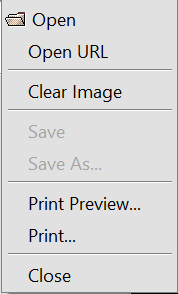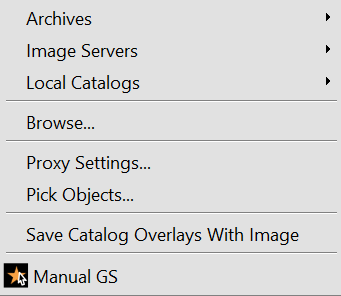PE Main Menu
The position editor menu bar is used to configure the image and overlay displays:
- File – open, save and print images
- View – configure and examine the image properties (including cut levels, color table and FITS header)
- Go – navigate the image history list
- Graphics – annotate the image with text and graphics. These can be saved with the underlying image
- Catalog – access on-line source catalogs (including guide star), image servers (including sky survey), archives and personal catalogs, configure the display of catalog overlays and access the catalog navigator. The overlays can be saved with the underlying image.
File Menu
Any simple FITS image may be loaded into the position editor. If the image has multiple planes, a summary of the image extensions is reported and you can choose which extension to display.
The raw image can be saved to a FITS file or in one of several file formats (e.g. jpeg, tiff, bitmap) from the file save as menu. You can save any graphics (overlays, annotations) as an extension in the FITS file using the graphics save graphics with image menu. Likewise you can save catalogs in a FITS extension using the catalog…save catalog overlays with image menu. This FITS file may be loaded into the position editor at a later time, the image displayed and extensions selected and displayed using the manipulation tools.
Alternatively, and more portably, you can save the overlays along with the image in jpeg or gif formats from the file save current view menu. This format is particularly useful if you have annotated the image e.g., as a finding chart.
The image with overlays can be printed, and previewed, directly from within the position editor or by printing an image saved to disk.
To close the position editor select file -> close or click on the X in the upper right corner.
View Menu
The main toolbar may be toggled off or on by selecting the Toolbar option in the View menu. You may also change how the main toolbar is displayed by going to the ‘Show Toolbar As‘ options and selecting from ‘Pictures and Text‘ (the default setting), ‘Pictures Only‘, and ‘Text Only‘.
From the Colors option you may change the color scale algorithm.
You can interactively change the high and low cut levels either manually, by selecting the percentile range or the median clipped range from the Cut Levels GUI. Cut Levels are also adjustable from the PE Main Toolbar.
The view fits extensions menu shows the various data structures contained in the FITS file. This may simply be the image plane or may include header and data extensions. If you have used the position editor to save an image with a catalog then
select the appropriate FITS table extension name and click open. This opens the catalog navigator from which you can plot (or unplot) the cataloged objects.
The keywords, values and comments in the current FITS header are displayed with the FITS Keywords menu.
The Scale option allows you to zoom in or out on your field.
The various Display options allow you to toggle the options for the various overlays available on your science field.
Go Menu
The position editor maintains a history list of images displayed. You can navigate forwards or backwards through the list, jump to a particular image, or clear the history list from items in the Go Menu. Note that different images can be selected by accessing Catalog -> Image Servers.
Graphics Menu
The OT allows the user to place graphical and text overlays on their field of interest. This may be of use for providing or supplementing finder charts for your observations. The options available are self explanatory to anyone who has used a basic graphics package in the past and will not be explained here. Please contact us if you have any specific issues or questions.
Catalog Menu
From the Catalog Menu you may access and display on-line object and image catalogs. Object catalogs may be filtered to aid your selection of suitable sources for guiding.
Several data centers maintain object catalogs and image servers that can be interrogated remotely. The Position Editor contains a powerful Catalog Navigator for downloading an image of the field around the science target plus the co-ordinates and other properties of objects within this field. This is particularly useful when laying out the telescope offset pattern and when selecting guide stars.
In addition to the on-line catalogs, you can overlay your own cataloged objects on the image. To study the require formats, e.g., the skycat style of tab-separated columns, it is useful to save and examine a downloaded catalog using the catalog navigator’s file save as menu.






